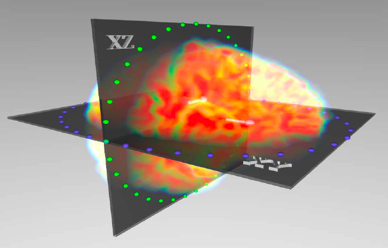| EEG Source Localization by Analytic Sensing |
Investigators: Djano Kandaswamy, Dimitri Van De Ville |
|
Summary: In this project, we propose a new theoretical framework that leads to a non-iterative technique for EEG source imaging. We designate our method as "analytic sensing," since the key contribution is to apply analytic sensors (functions with vanishing Laplacian in some domain) that sense the influence of the source distribution in a specific region. |
|
Imaging the functioning of the human brain is an important task in neurosciences and neurology. For that purpose, positron emission tomography (PET) and functional magnetic resonance imaging (fMRI) are playing an important role and provide good spatial resolution. However, to access the temporal properties of the brain circuits, electro- and magneto-encephalography (EEG, MEG) are predominant since they allow measuring signals down to millisecond resolution. Mapping back the measured signal on the scalp surface to the source configuration inside the brain is known as "source imaging." Unfortunately, the underlying electromagnetic inverse problem is ill posed since an infinity of different source configurations can explain the same scalp potential. Therefore, additional assumptions are required to make the solution unique. For this purpose, the various methods available are putting forward different hypotheses about the source model (single-dipole, multi-dipole, or distributed) and its properties, such as smoothness. |
|
 |
| Artistic rendering of analytic sensing |
Our approach can be applied for multi-pole or multi-dipole source models, bringing together the following several attractive features:
- the nonlinear (dipole positions) and linear (dipolar moments) estimation steps are decoupled;
- the nonlinear estimation is direct (noniterative) and fast;
- no forward model is needed, while the scalp surface can be nonspherical;
- the method can be spatially selective to only incorporate the influence of sources in a desired region-of-interest.
In addition to theoretical developments, we aim at a fully functional EEG source-imaging method that can be applied to, and validated by, experimental data, for example focal epileptic activity and evoked response potentials (ERPs). The flexibility of the method, which allows one to apply local analytic sensing and to resolve multi-pole source models, makes it a great candidate to go beyond current state-of-the-art EEG source imaging. |
|
Collaborations: Prof. Thierry Blu (Chinese University of Hong Kong), Prof. Christoph Michel (UniGE, EEG Lab), Dr. Laurent Spinelli (HUG, Brain Mapping Unit) |
|
|
Funding: SNSF project granted |
|
|
[1] | D. Kandaswamy, T. Blu, L. Spinelli, C. Michel, D. Van De Ville, "EEG Source Localization by Multi-Planar Analytic Sensing," Proceedings of the Fifth IEEE International Symposium on Biomedical Imaging: From Nano to Macro (ISBI'08), Paris, France, May 14-17, 2008, pp. 1075-1078.
|
[2] | D. Kandaswamy, T. Blu, D. Van De Ville, "Analytic Sensing: Direct Recovery of Point Sources from Planar Cauchy Boundary Measurements," Proceedings of the SPIE Optics and Photonics 2007 Conference on Mathematical Methods: Wavelet XII, San Diego CA, USA, August 26-29, 2007, vol. 6701, pp. 67011Y-1/67011Y-6.
|
|
|
|
